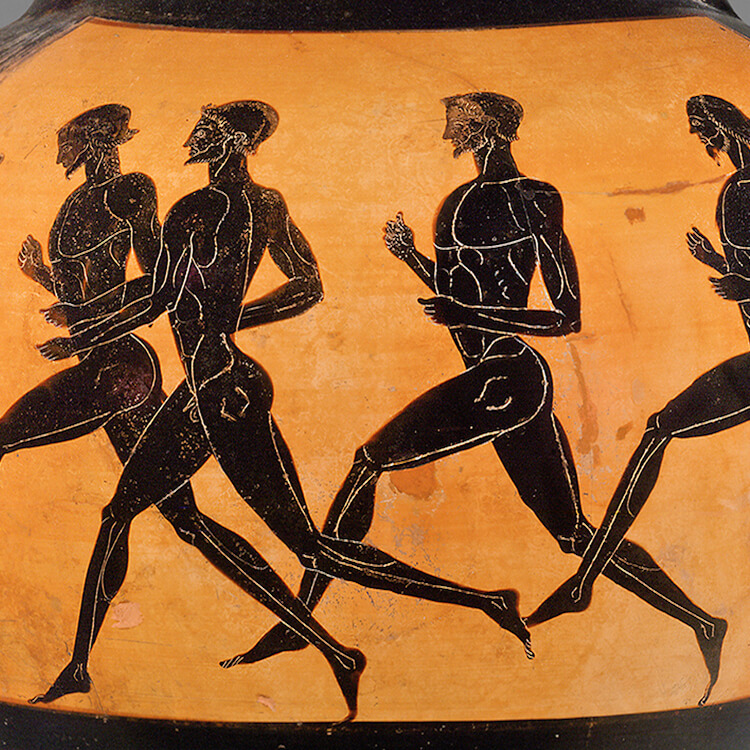PRINCETON, New Jersey — The Attic Greek vase-painter, also known conventionally as Berlin Painter, finally had his day in the spotlight with his first solo exhibition The Berlin Painter and His World at Princeton Art Museum (March 4- June 11, 2017) featured an astonishing oeuvre of his work. The exhibition featured eighty-four vessels and statuettes of the early fifth century B.C., including fifty-four of the finest vases attributed to the Berlin Painter, the museum writes.
The Berlin Painter’s style is distinguished by a suave elegance and a palpable tension between shape and decoration. His figures, and the ornament accompanying them, are executed with taut, dexterous precision, whether on water jars (hydriai), large wine bowls (kraters), or smaller shapes such as jugs (oinochoai) and oil bottles (lekythoi). The single figures on either side of his amphorae frequently share the same conceptual space. Accompanied by little or no ornament and spotlighted against the black ground, they are framed only by the contours of the vessel itself.
Featured image: Greek, Attic, attributed to the Berlin Painter, Greek, Attic, fl. ca. 500-ca. 460 B.C., Black-figure Panathenaic Prize Amphora: A, Athena between Columns Topped by Cocks, B, Runners (pictured), ca. 480–470 B.C., Ceramic, 24 1/2 × 16 1/2 × 7 5/16 × 5 1/2 inches. Courtesy Collection of Gregory Callimanopulos, New York

The Berlin Painter and His World is a celebration of ancient Greece and of the ideals of reason, proportion, and human dignity that are its legacy. Focusing on the extraordinary work of a single anonymous master artisan, the exhibition provides a window onto ancient Athenian society at a time of economic growth and cultural flourishing through the art of vase-painting, the largest body of pictorial imagery to have survived from antiquity. Depictions of myths, cult, and daily life on red-figure vases posit questions on love and war, life and death, that still resonate today.

Greek, Attic attributed to the Berlin Painter, Greek, Attic, fl. ca. 500-ca. 460 B.C., Red-figure Amphora of Type A: A, Athena (pictured), B, Herakles, ca. 500–490 B.C., Ceramic, 26 9/16 × 31 1/8 × 16 7/8 × 12 13/16 × 9 5/8 inches. Courtesy Antikenmuseum Basel und Sammlung Ludwig

detail
The objects gathered from museums and private collections around the globe, and examines the elements of this artist’s style that allow the attribution of objects to his hand while affording unique insights into life 2,500 years ago.

Greek, Attic, attributed to the Berlin Painter, Greek, Attic, fl. ca. 500-ca. 460 B.C.Red-figure volute-krater: A, Achilles and Hektor, B, Achilles and Memnon, ca. 490 B.C., Ceramic, 25 1/8 × 18 9/16 × 9 5/16 inches. Courtesy The British Museum

Greek, Attic, attributed to the Berlin Painter, Greek, Attic, fl. ca. 500-ca. 460 B.C., Red-figure Stamnos: A, Athena between Zeus and Hera (pictured), B, Departing Warrior between Woman and Seated Old Man, ca 490 -480 B.C., Ceramic, 13 9/16 × 9 1/16 inches. Courtesy: The Metropolitan Museum of Art

Greek, Attic, attributed to the Berlin Painter, Greek, Attic, fl. ca. 500-ca. 460 B.C., Red-figure Neck -amphora with Twisted Handles: A, Dionysos with Thyrsos, Kanthanros and Lion, B, Satyr Carrying a Wineskin (pictured), ca. 480. B.C., Ceramic, 19 11/16 inches. Courtesy Staatliche Antikensammlungen und Glyptothek München

Greek, Attic, attributed to the Berlin Painter, Greek, Attic, fl. ca. 500-ca. 460 B.C., Red-figure Neck -amphora with Tidged Handles: Amazonmachy with Herkales, ca 485-480 B.C., Ceramic, 21 5/8 × 11 7/8 × 7 1/2 × 6 9/16 inches. Courtesy Antikenmuseum Basel und Sammlung Ludwig

Greek, Attic
attributed to the Berlin Painter, Greek, Attic, fl. ca. 500-ca. 460 B.C., Black-figure Panathenaic Prize Amphora: A, Athena between Columns Topped by Cocks, B, Runners (pictured), ca. 480–470 B.C., Ceramic, 24 1/2 × 16 1/2 × 7 5/16 × 5 1/2 inches. Courtesy Collection of Gregory Callimanopulos, New York
Text (edited) from museum.
Read a delicious in-depth essay by J. Michael Padgett, Curator of Ancient Art at Princeton Art Museum.
Do you love or loathe Attic Greek works from the world of ceramic art. Let us know in the comments.

A fascinating lecture by the curator can be found at Youtube Berlin Painter.
You may also check the chapters on “The Classical Aesthetics” for the form of Greek vases and “The Narrative Aesthetics” for their surfaces in my book “The Art of the Future” available online for free at http://www.paulmathieu.ca/theartof the future